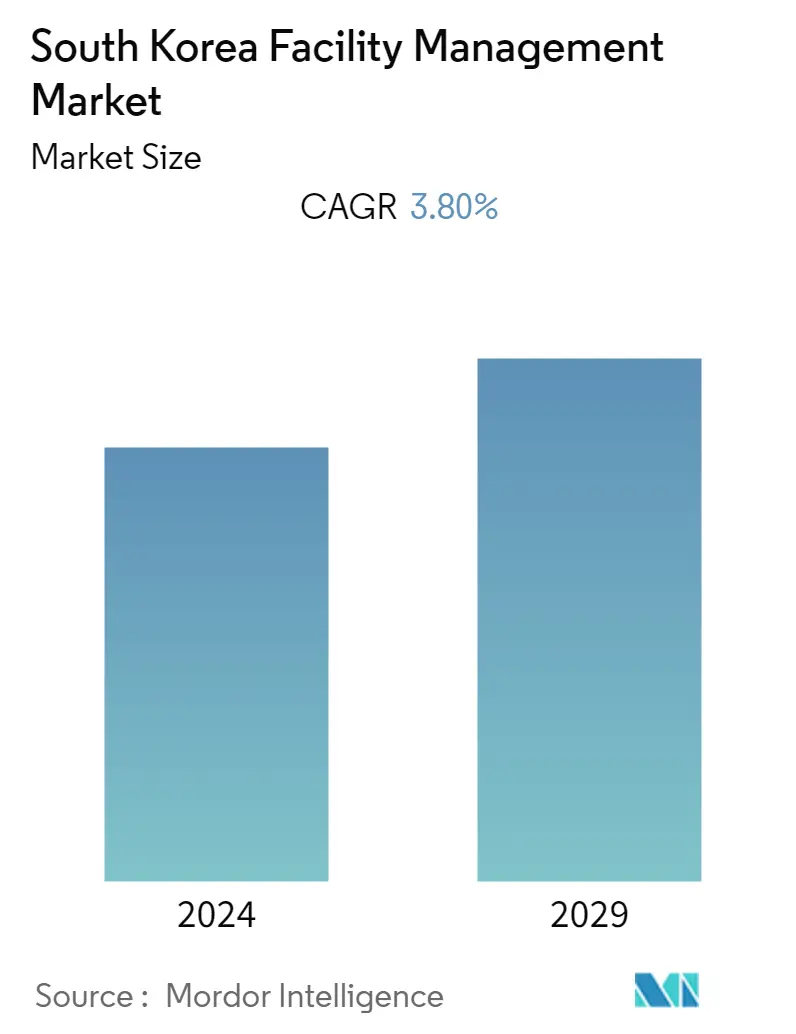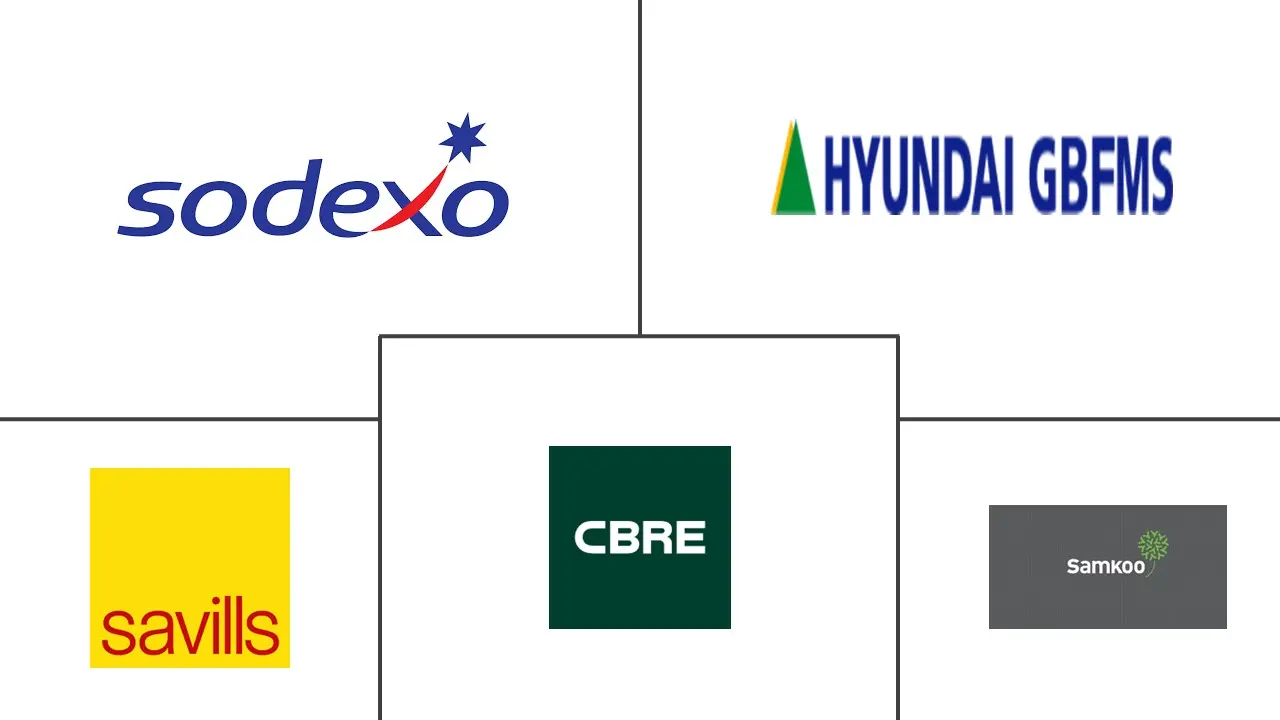Market Size of South Korea Facility Management Industry

| Study Period | 2019 - 2029 |
| Base Year For Estimation | 2023 |
| Forecast Data Period | 2024 - 2029 |
| Historical Data Period | 2019 - 2022 |
| CAGR | 3.80 % |
| Market Concentration | Medium |
Major Players
*Disclaimer: Major Players sorted in no particular order |
South Korea Facility Management Market Analysis
The South Korea Facility Management market is expected to grow during the forecast period by registering a CAGR of 3.8% during 2022-2027.
- South Korea is one of the countries with the largest number of buildings with high stories. With most buildings now fitted with state-of-the-art technology, a skilled workforce is needed to maintain them. This is turning more companies towards outsourcing their facility management to experts who can ensure they meet regulatory stipulations. Increasing cooperation between conglomerates and foreign facility management companies is expected to drive the market.
- With the re-kindled focus on economic policies and expansion of services post Covid-19, the financial management market is expected to grow significantly owing to the increasing adoption of work optimization and productivity. Further, the facility manager's role is growing more notable and changing from operational to strategic.
- The COVID-19 pandemic has presented itself as an opportunity for the facility manager to consolidate the new office environment and address the demands of employees in terms of working from home in the corporate culture. Though, more compliance is anticipated, also concerning suppliers. The focus will be more on quality and results and less on a fixed schedule.
- However, labor-management relations and inflexible labor laws have been an ongoing problem in South Korea. Additionally, the increasingly stringent building regulations and rising green facility management trends are expected to provide impetus. Another driving factor is strong support from Government and regulatory bodies on sustainability, energy efficiency, and green management.
South Korea Facility Management Industry Segmentation
Facility management (FM) is a profession that incorporates many disciplines to ensure functionality, safety, comfort, and efficiency of the built environment by integrating people, process, place, and technology. FMs contribute to the business's bottom line through its responsibility for maintaining what is often an organization's most significant and most valuable assets, such as property, equipment, buildings, and other environments that house personnel, productivity, inventory, and other elements of the operation.
Facility management services involve the management of building upkeep, utilities, maintenance operations, waste services, security, etc. These services are further divided into hard facility management services and soft facility management services spheres.
Both in-house facility management and outsourced FM services are considered in the scope. The market for integrated facility management service (IFM), along with single and bundled services, is included in the outsourced FM services segment.
South Korea Facility Management Market is segmented by Type of Facility Management (In-house Facility Management and Outsourced Facility Management (Single FM, Bundled FM, Integrated FM)), by Offering type (Hard FM, Soft FM), and by End-user (Commercial, Institutional, Public/Infrastructure, Industrial).
| By Type of Facility Management | |||||
| Inhouse Facility Management | |||||
|
| By Offering Type | |
| Hard FM | |
| Soft FM |
| By End-User | |
| Commercial | |
| Institutional | |
| Public/Infrastructure | |
| Industrial | |
| Others |
South Korea Facility Management Market Size Summary
The South Korea Facility Management market is poised for growth, driven by the increasing complexity of building management and the need for specialized expertise. As the country boasts a significant number of high-rise buildings equipped with advanced technologies, there is a growing trend towards outsourcing facility management to ensure compliance with regulatory standards. The market is further bolstered by collaborations between local conglomerates and international facility management firms, which are expected to enhance service offerings. The post-COVID-19 landscape has shifted the role of facility managers from operational to strategic, focusing on optimizing work environments and boosting productivity. Additionally, the government's emphasis on sustainability and energy efficiency, alongside the rise of green facility management practices, is expected to propel market expansion.
The market landscape is characterized by a competitive environment with numerous players engaging in strategic partnerships, mergers, and acquisitions to strengthen their market position. Significant investments in infrastructure and real estate, supported by government initiatives, are set to drive demand for facility management services. The influx of foreign investments and the establishment of new manufacturing facilities, particularly in the industrial and EV sectors, are contributing to the market's growth. Companies are increasingly adopting advanced technologies and smart building solutions to enhance operational efficiency. Key players in the market, such as Samkoo Inc Co., Ltd, Hyundai GBFMS, and CBRE Group, Inc., are actively expanding their service offerings to meet the evolving needs of clients, thereby fostering a dynamic and growth-oriented market environment.
South Korea Facility Management Market Size - Table of Contents
-
1. MARKET INSIGHTS
-
1.1 Market Overview
-
1.2 Industry Attractiveness- Porter's Five Forces Analysis
-
1.2.1 Bargaining Power of Suppliers
-
1.2.2 Bargaining Power of Consumers
-
1.2.3 Threat of New Entrants
-
1.2.4 Threat of Substitutes
-
1.2.5 Intensity of Competitive Rivalry
-
-
1.3 Impact of COVID-19 on the Market
-
-
2. MARKET SEGMENTATION
-
2.1 By Type of Facility Management
-
2.1.1 Inhouse Facility Management
-
2.1.2 Outsourced Facility Management
-
2.1.2.1 Single FM
-
2.1.2.2 Bundled FM
-
2.1.2.3 Integrated FM
-
-
-
2.2 By Offering Type
-
2.2.1 Hard FM
-
2.2.2 Soft FM
-
-
2.3 By End-User
-
2.3.1 Commercial
-
2.3.2 Institutional
-
2.3.3 Public/Infrastructure
-
2.3.4 Industrial
-
2.3.5 Others
-
-
South Korea Facility Management Market Size FAQs
What is the current South Korea Facility Management Market size?
The South Korea Facility Management Market is projected to register a CAGR of 3.80% during the forecast period (2024-2029)
Who are the key players in South Korea Facility Management Market?
Samkoo Inc Co., Ltd, Hyundai GBFMS, CBRE Group, Inc., Sodexo Oy and Savills Plc are the major companies operating in the South Korea Facility Management Market.

